文章目录
- 一、集成学习概述
- 二、Bagging模型
- 2.1 随机森林
- 2.1.1 随机森林介绍
- 2.2.1 随机森林优势
- 2.2 KNN
- 2.3 软投票
- 2.4 硬投票
- 2.5 Bagging模型实战
- 2.5.1 构建实验数据集
- 2.5.2 硬投票和软投票效果对比
- 2.5.2.1 硬投票效果
- 2.5.2.2 软投票效果
- 2.5.3 Bagging策略效果
- 2.5.3.1 用Bagging
- 2.5.3.2 不用Bagging
- 2.5.4 集成效果展示分析
- 2.5.5 OOB袋外数据的作用
- 2.5.6 特征重要性热度图展示
- 三、Boosting模型
- 3.1 AdaBoost
- 3.1.1 AdaBoost算法概述
- 3.1.2 SVM作为基本分类器实现AdaBoost
- 3.1.3 Sklearn实现AdaBoost
- 3.2 Gradient Boosting(GBDT)
- 3.2.1 用代码体会GBDT思想
- 3.2.3 Sklearn实现GBDT
- 3.2.3 提前停止策略
- 3.2.4 停止方案实施
- 四、Stacking模型
- 4.1 Stacking模型简介
- 4.2 代码体会Stacking模型思想
一、集成学习概述
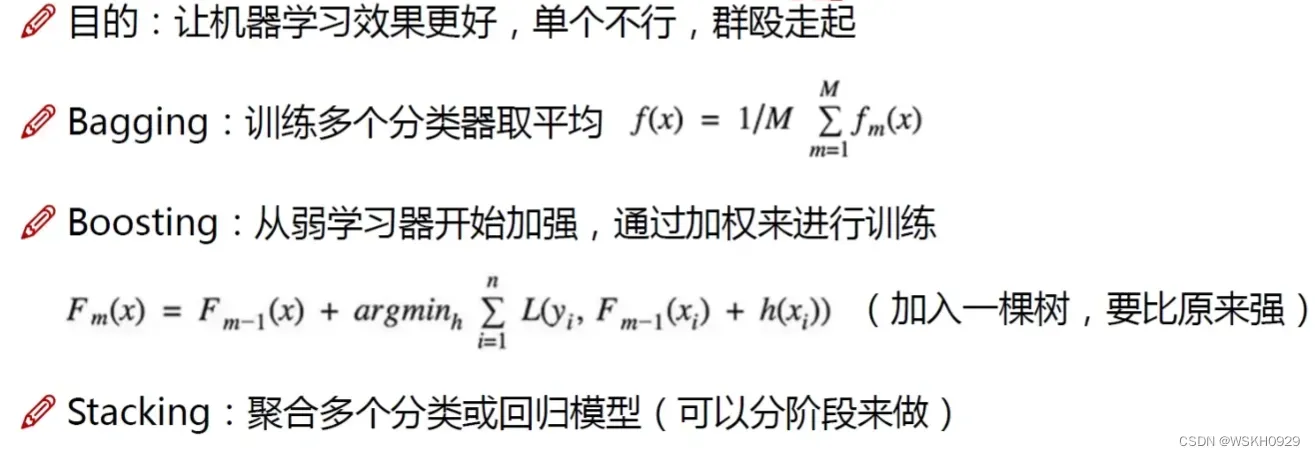
二、Bagging模型
Bagging模型:并行训练一堆分类器,然后对所有分类器的结果求平均作为最后的结果
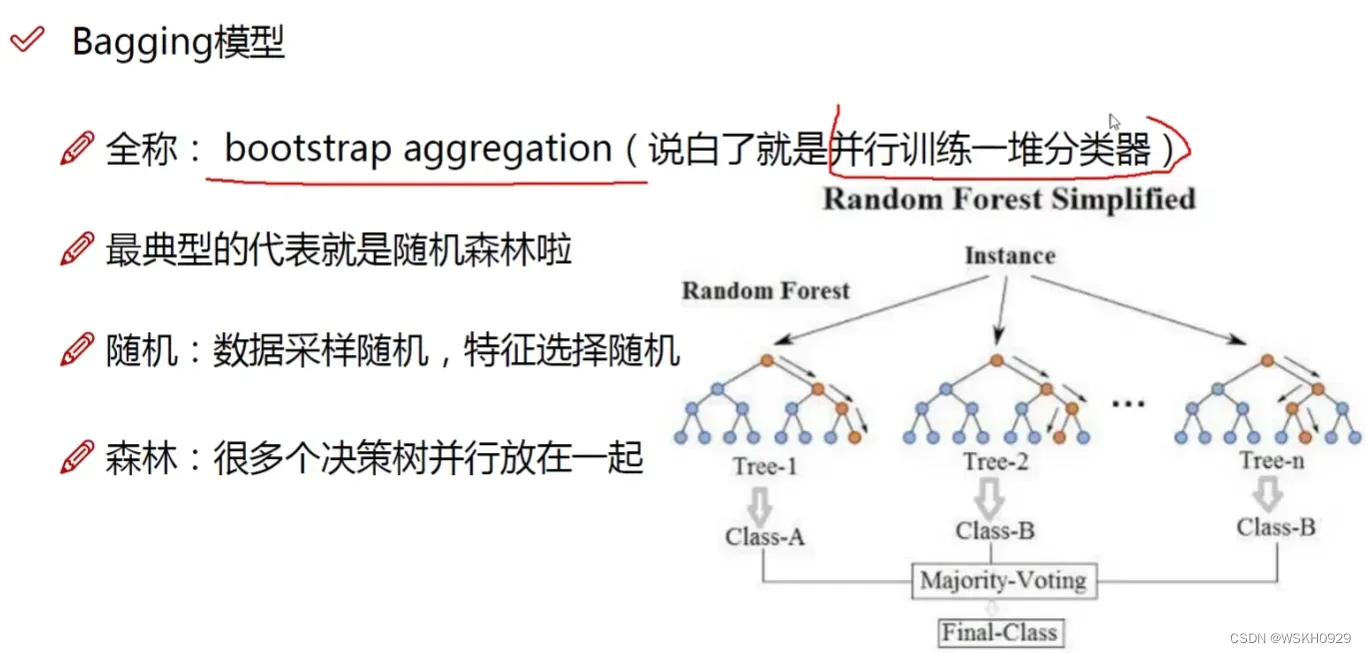
2.1 随机森林
2.1.1 随机森林介绍
Bagging模型中最典型的代表是:随机森林
随机:数据随机采样,特征选择随机
森林:多个决策树并行放在一起
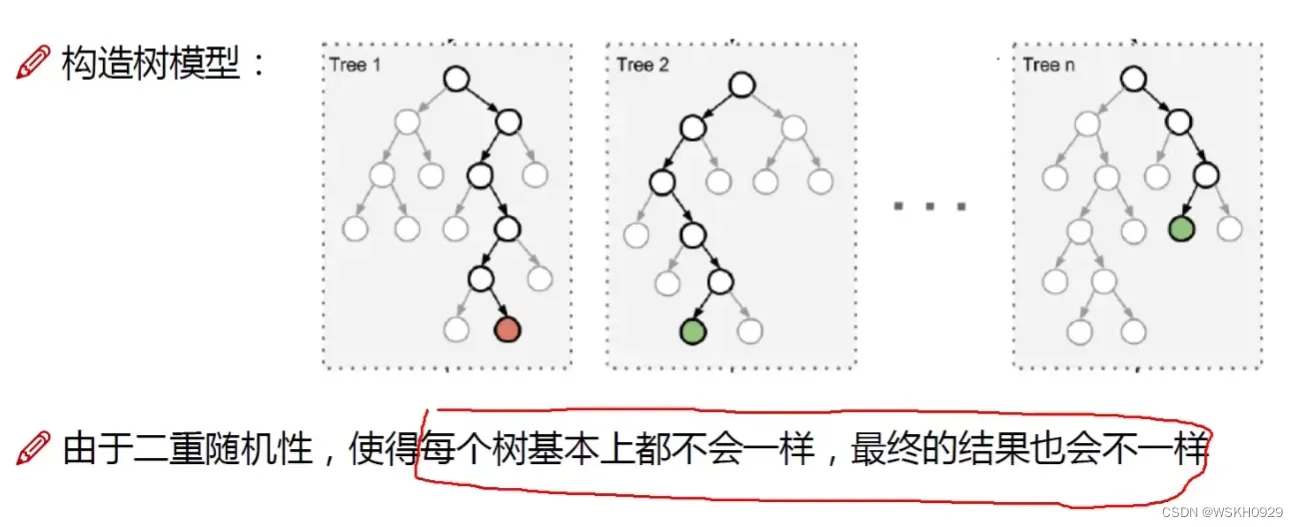

2.2.1 随机森林优势
- 能够处理高维度数据,并且不用做特征选择
- 训练完后,它能够给出哪些特征比较重要
- 容易并行化,速度较快
- 可以进行可视化展示,方便分析
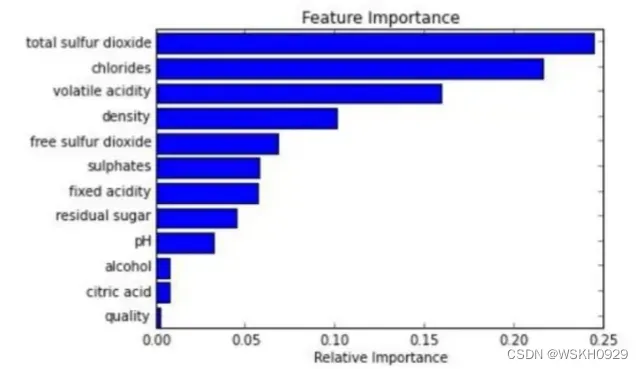
2.2 KNN
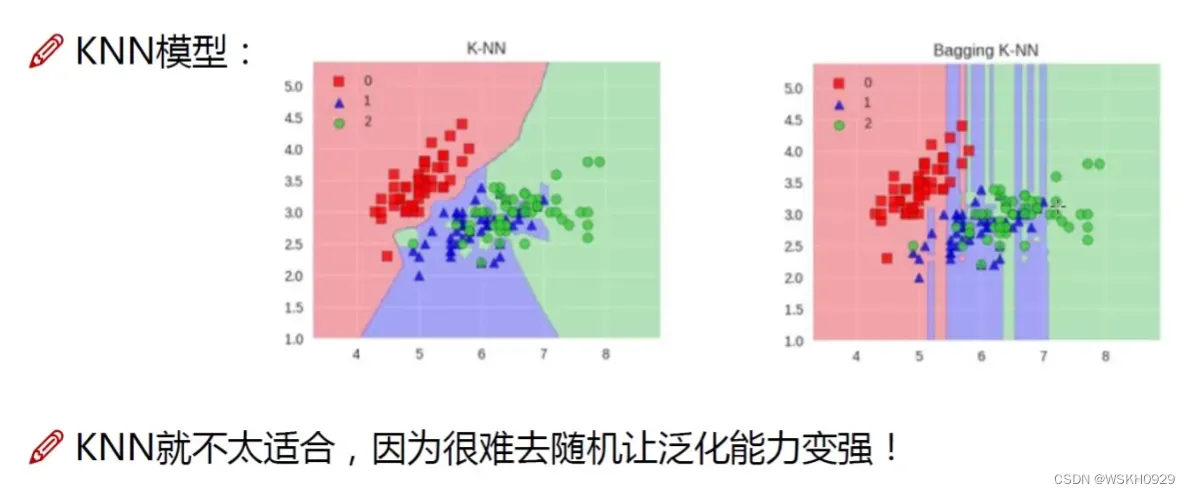
2.3 软投票
加权平均

2.4 硬投票
少数服从多数
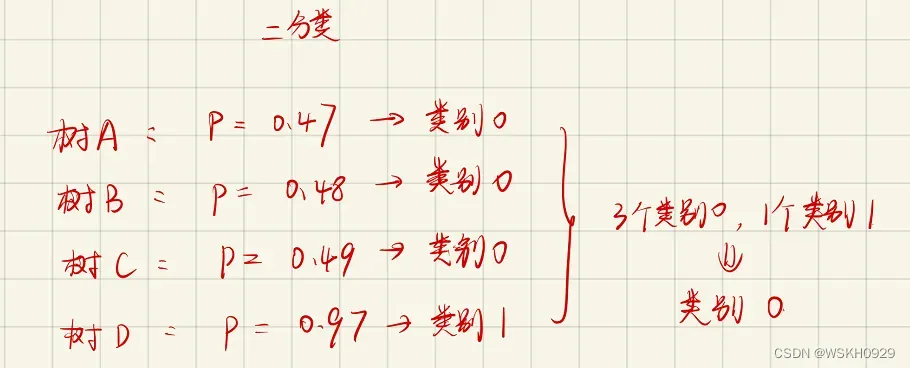
2.5 Bagging模型实战
2.5.1 构建实验数据集
from sklearn.model_selection import train_test_split
from sklearn.datasets import make_moons
import matplotlib.pyplot as plt
X, y = make_moons(n_samples=500, noise=0.30, random_state=42)
X_train, X_test, y_train, y_test = train_test_split(X, y, random_state=42)
plt.plot(X[:, 0][y == 0], X[:, 1][y == 0], 'yo', alpha=0.6)
plt.plot(X[:, 0][y == 0], X[:, 1][y == 1], 'bs', alpha=0.6)
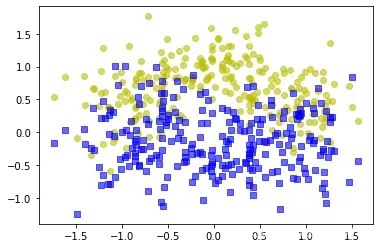
2.5.2 硬投票和软投票效果对比
2.5.2.1 硬投票效果
from sklearn.ensemble import RandomForestClassifier, VotingClassifier
from sklearn.linear_model import LogisticRegression
from sklearn.svm import SVC
from sklearn.metrics import accuracy_score
log_clf = LogisticRegression(random_state=520)
rnd_clf = RandomForestClassifier(random_state=520)
svm_clf = SVC(random_state=520)
voting_clf = VotingClassifier(estimators=[('lr', log_clf), ('rf', rnd_clf),
('svc', svm_clf)],
voting='hard')
for clf in (log_clf, rnd_clf, svm_clf, voting_clf):
clf.fit(X_train, y_train)
y_pred = clf.predict(X_test)
print(clf.__class__.__name__, accuracy_score(y_test, y_pred))
输出:
LogisticRegression 0.864
RandomForestClassifier 0.872
SVC 0.896
VotingClassifier 0.888
2.5.2.2 软投票效果
from sklearn.ensemble import RandomForestClassifier, VotingClassifier
from sklearn.linear_model import LogisticRegression
from sklearn.svm import SVC
from sklearn.metrics import accuracy_score
log_clf = LogisticRegression(random_state=520)
rnd_clf = RandomForestClassifier(random_state=520)
svm_clf = SVC(random_state=520,probability=True)
voting_clf = VotingClassifier(estimators=[('lr', log_clf), ('rf', rnd_clf),
('svc', svm_clf)],
voting='soft')
for clf in (log_clf, rnd_clf, svm_clf, voting_clf):
clf.fit(X_train, y_train)
y_pred = clf.predict(X_test)
print(clf.__class__.__name__, accuracy_score(y_test, y_pred))
输出:
LogisticRegression 0.864
RandomForestClassifier 0.872
SVC 0.896
VotingClassifier 0.912
结论:软投票比硬投票更靠谱一些
2.5.3 Bagging策略效果
2.5.3.1 用Bagging
from sklearn.ensemble import BaggingClassifier
from sklearn.tree import DecisionTreeClassifier
bag_clf = BaggingClassifier(DecisionTreeClassifier(),
n_estimators=500,
max_samples=100,
bootstrap=True,
n_jobs=-1,
random_state=520)
bag_clf.fit(X_train, y_train)
y_pred = bag_clf.predict(X_test)
print(accuracy_score(y_test, y_pred))
输出:
0.904
2.5.3.2 不用Bagging
tree_clf = DecisionTreeClassifier(random_state=42)
tree_clf.fit(X_train, y_train)
y_pred_tree = tree_clf.predict(X_test)
print(accuracy_score(y_test, y_pred_tree))
输出:
0.856
结论:用Bagging策略的预测效果更好
2.5.4 集成效果展示分析
from matplotlib.colors import ListedColormap
def plot_decision_boundary(clf,
X,
y,
axes=[-1.5, 2.5, -1, 1.5],
alpha=0.5,
contour=True):
x1s = np.linspace(axes[0], axes[1], 100)
x2s = np.linspace(axes[2], axes[3], 100)
x1, x2 = np.meshgrid(x1s, x2s)
X_new = np.c_[x1.ravel(), x2.ravel()]
y_pred = clf.predict(X_new).reshape(x1.shape)
custom_cmap = ListedColormap(['#fafab0', '#9898ff', '#a0faa0'])
plt.contourf(x1,x2,y_pred,cmap=custom_cmap,alpha=0.3)
if contour:
custom_cmap2 = ListedColormap(['#7d7d58', '#4c4c7f', '#507d50'])
plt.contour(x1, x2, y_pred)
plt.plot(X[:, 0][y == 0], X[:, 1][y == 0], 'yo', alpha=0.6)
plt.plot(X[:, 0][y == 0], X[:, 1][y == 1], 'bs', alpha=0.6)
plt.axis(axes)
plt.xlabel('x1')
plt.xlabel('x2')
plt.figure(figsize=(12, 5))
plt.subplot(121)
plot_decision_boundary(tree_clf, X, y)
plt.title('Decision Tree')
plt.subplot(122)
plot_decision_boundary(bag_clf, X, y)
plt.title('Decision Tree With Bagging')

结论:采用Bagging策略的模型过拟合风险更小
2.5.5 OOB袋外数据的作用
bag_clf = BaggingClassifier(DecisionTreeClassifier(),
n_estimators=500,
max_samples=100,
bootstrap=True,
n_jobs=-1,
random_state=42,
oob_score=True)
bag_clf.fit(X_train, y_train)
print(bag_clf.oob_score_)
输出:
0.9253333333333333
y_pred = bag_clf.predict(X_test)
print(accuracy_score(y_test, y_pred))
输出:
0.904
结论:OOB袋外数据可以作为验证集对模型进行准确率的计算,比测试集计算的准确率略高,但相差不多
2.5.6 特征重要性热度图展示
from sklearn.datasets import load_iris
iris = load_iris()
rf_clf = RandomForestClassifier(n_estimators=500, n_jobs=-1)
rf_clf.fit(iris['data'], iris['target'])
for name, score in zip(iris['feature_names'], rf_clf.feature_importances_):
print(name, score)
输出:
sepal length (cm) 0.09370373939142465
sepal width (cm) 0.022001401734976455
petal length (cm) 0.4505649464716102
petal width (cm) 0.4337299124019887
from sklearn.datasets import fetch_openml
import matplotlib
mnist = fetch_openml('mnist_784')
def plot_digit(data):
image = data.reshape(28, 28)
plt.imshow(image, cmap=matplotlib.cm.hot)
plt.axis('off')
rf_clf = RandomForestClassifier(n_estimators=500, n_jobs=-1)
rf_clf.fit(mnist['data'], mnist['target'])
plot_digit(rf_clf.feature_importances_)
char = plt.colorbar(ticks=[
rf_clf.feature_importances_.min(),
rf_clf.feature_importances_.max()
])
char.ax.set_yticklabels(['Not important', 'Very importang'])
输出:

结论:RF输出的特征重要性热度图表示(颜色越接近黑色表示特征越不重要),在手写数据集中,中间的像素(特征)较为重要
三、Boosting模型
典型代表:AdaBoost、Xgboost
AdaBoost会根据前一次的分类效果调整数据权重
解释:如果某一个数据在这次分错了,那么在下一次我就会给它更大的权重
最终的结果:每个分类器根据自身的准确性来确定各自的权重,再合体
3.1 AdaBoost
3.1.1 AdaBoost算法概述
跟上学考试一样,这次做错的题,需要额外注意,下次就不要做错了


3.1.2 SVM作为基本分类器实现AdaBoost
plt.figure(figsize=(14, 6))
learning_rate = 1
sample_weights = np.ones(len(X_train))
for i in range(5):
svm_clf = SVC(kernel='rbf', C=0.05, random_state=42)
svm_clf.fit(X_train, y_train, sample_weight=sample_weights)
y_pred = svm_clf.predict(X_train)
sample_weights[y_pred != y_train] *= (1 + learning_rate)
plot_decision_boundary(svm_clf, X, y, alpha=0.2)
plt.title('learning_rate = {}'.format(learning_rate))
plt.text(-0.7, -0.65, "1", fontsize=14)
plt.text(-0.6, -0.10, "2", fontsize=14)
plt.text(-0.5, 0.10, "3", fontsize=14)
plt.text(-0.4, 0.55, "4", fontsize=14)
plt.text(-0.3, 0.90, "5", fontsize=14)
plt.show()
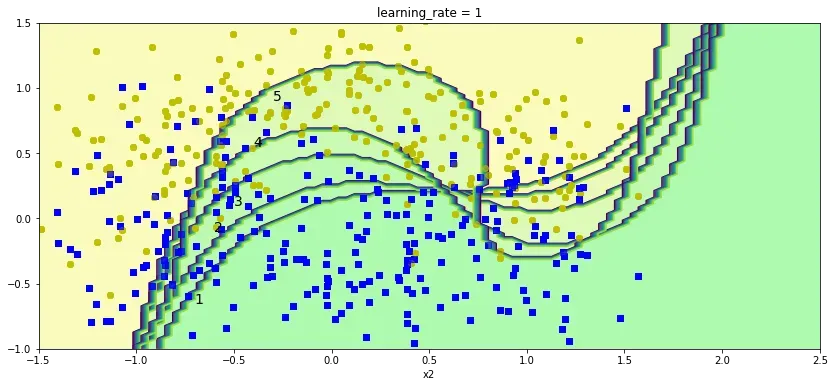
plt.figure(figsize=(14, 6))
learning_rate = 0.5
sample_weights = np.ones(len(X_train))
for i in range(5):
svm_clf = SVC(kernel='rbf', C=0.05, random_state=42)
svm_clf.fit(X_train, y_train, sample_weight=sample_weights)
y_pred = svm_clf.predict(X_train)
sample_weights[y_pred != y_train] *= (1 + learning_rate)
plot_decision_boundary(svm_clf, X, y, alpha=0.2)
plt.title('learning_rate = {}'.format(learning_rate))
plt.show()
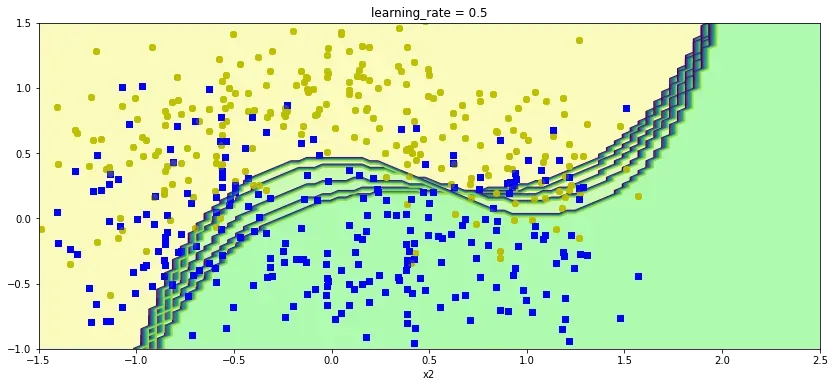
结论:AdaBoost中,学习率越大,每一步的更新就越快
3.1.3 Sklearn实现AdaBoost
from sklearn.ensemble import AdaBoostClassifier
ada_clf = AdaBoostClassifier(DecisionTreeClassifier(max_depth=1),
n_estimators=200,
learning_rate=0.5,
random_state=42)
ada_clf.fit(X_train,y_train)
plot_decision_boundary (ada_clf,X,y)

3.2 Gradient Boosting(GBDT)
GBDT中的代表模型:
- GDBT(第一代)
- XgBoost(第二代)
- LightGBM(第三代,效果通常最好)
下图展现了GBDT的提升过程,通过不断加入树去弥补之前的Loss,使得模型整体预测效果得到提升:

3.2.1 用代码体会GBDT思想
# 导入库
from sklearn.tree import DecisionTreeRegressor
from sklearn.metrics import mean_absolute_error
# 构造测试数据
np.random.seed(42)
X = np.random.rand(100, 1) - 0.5
y = 3 * X[:, 0] * 2 + 0.05 * np.random.randn(100)
# 开始Gradient Boost循环
y_lst = [y]
tree_regl_lst = []
for i in range(10):
# 实例化决策树回归器 max_depth=2 防止过拟合
tree_regl = DecisionTreeRegressor(max_depth=2)
tree_regl.fit(X,y_lst[i])
y_hat = tree_regl.predict(X)
print("MAE:",mean_absolute_error(y_lst[i],y_hat))
y_lst.append(y_lst[i] - y_hat)
tree_regl_lst.append(tree_regl)
输出:
MAE: 0.35567640260211664
MAE: 0.2757033790340715
MAE: 0.2220536712621441
MAE: 0.18640823041945379
MAE: 0.15983867589863676
MAE: 0.13915823769411198
MAE: 0.11948140923031975
MAE: 0.10646877400035713
MAE: 0.1036924652651969
MAE: 0.09089276292058762
结论:GDBT通过不断加入树,对上一次Loss进行再次训练,从而改进整体Loss
3.2.3 Sklearn实现GBDT
from sklearn.ensemble import GradientBoostingRegressor
gbrt = GradientBoostingRegressor(max_depth=2,
n_estimators=3,
learning_rate=1.0,
random_state=41)
gbrt.fit(X, y)
3.2.3 提前停止策略
from sklearn.metrics import mean_squared_error
X_train, X_val, y_train, y_val = train_test_split(X, y, random_state=49)
gbrt = GradientBoostingRegressor(max_depth=2,
n_estimators=120,
random_state=42)
gbrt.fit(X_train, y_train)
errors = [
mean_squared_error(y_val, y_pred) for y_pred in gbrt.staged_predict(X_val)
]
# 最佳迭代次数
bst_n_estimators = np.argmin(errors)
# 最小error
min_error = np.min(errors)
plt.figure(figsize = (11,4))
plt.plot (errors,'b.-')
plt.plot ([bst_n_estimators,bst_n_estimators],[0,min_error],'r--')
plt.plot ([0,120],[min_error,min_error],'r--')
plt.axis([0,120,0,0.01])
plt.title('Val Error')

从上图可以看出,GBDT中不是加入树越多越好,在加入75个树往后,Error反而升高了,所以我们需要找到最佳树的个数,而不是一味地增加树的个数
3.2.4 停止方案实施
利用Sklearn提供的GBDT接口的热启动参数,使得模型每一次训练的信息得以保留,下一次可以接着训练
然后每次迭代判断当前损失是否提升,如果是则对error_going_up进行加1操作,当error_going_up达到一个阈值,则提前终止
# warm_start 热启动,保存上一次训练的信息,接着训练
gbrt = GradientBoostingRegressor(max_depth=2, random_state=42, warm_start=True)
error_going_up = 0
min_val_error = float('inf')
for n_estimators in range(1, 120):
gbrt.n_estimators = n_estimators
gbrt.fit(X_train, y_train)
y_pred = gbrt.predict(X_val)
val_error = mean_squared_error(y_val, y_pred)
if val_error < min_val_error:
min_val_error = val_error
error_going_up = 0
else:
error_going_up += 1
if error_going_up == 5:
print("best_n_estimators:",n_estimators)
break
print("min_val_error:",min_val_error)
输出:
best_n_estimators: 80
min_val_error: 0.00683519138553835
四、Stacking模型
4.1 Stacking模型简介
堆叠:很暴力,拿来一堆直接上(各种分类器都来了)
可以堆叠各种各样的分类器(KNN、SVM、RF、神经网络等等)
分阶段:第一阶段得出各自的结果,第二阶段再用前一阶段的结果训练
为了刷结果,不择手段!


4.2 代码体会Stacking模型思想
from sklearn.ensemble import RandomForestClassifier, ExtraTreesclassifier
from sklearn.svm import LinearSVC
from sklearn.neural_network import MLPClassifier
# 定义一阶段的4个分类器
random_forest_clf = RandomForestClassifier(random_state=42)
extra_trees_clf = ExtraTreesClassifier(random_state=42)
svm_clf = LinearSVC(random_state=42)
mlp_clf = MLPClassifier(random_state=42)
estimators = [random_forest_clf, extra_trees_clf, svm_clf, mlp_clf]
# 训练每个一阶段的分类器
for estimator in estimators:
print("Training the",estimator)
estimator.fit(X_train,y_train)
# 获取一阶段的输出结果
X_val_predictions = np.empty((len(X_val),len(estimators)),dtype=np.float32)
for index,estimator in enumerate(estimators):
X_val_predictions[:,index]estimator.predict(X_val)
# 构造二阶段分类器
rnd_forest_blender = RandomForestClassifier(n_estimators=200,oob_score=True,random_state=42)
# 用一阶段的输出结果训练二阶段分类器
rnd_forest_blender.fit(X_val_predictions,y_val)
文章出处登录后可见!
